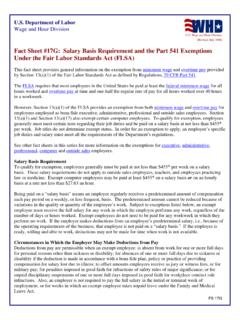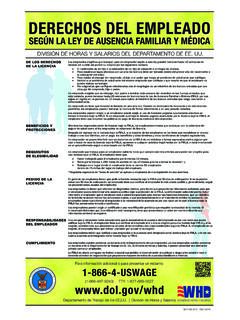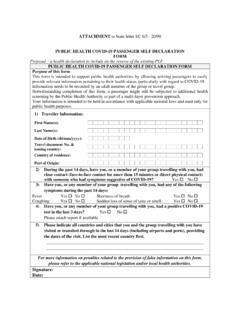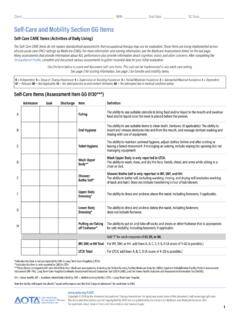Transcription of Self-Compliance Tool for the Mental Health Parity and ...
1 1 | Page Self-Compliance tool for the Mental Health Parity and Addiction Equity Act (MHPAEA) About This tool Introduction SECTION A. APPLICABILITY SECTION B. COVERAGE IN ALL CLASSIFICATIONS SECTION C. LIFETIME AND ANNUAL LIMITS SECTION D. FINANCIAL REQUIREMENTS AND QUANTITATIVE TREATMENT LIMITATIONS SECTION E. CUMULATIVE FINANCIAL REQUIREMENTS AND TREATMENT LIMITATIONS SECTION F. NONQUANTITATIVE TREATMENT LIMITATIONS SECTION G. DISCLOSURE REQUIREMENTS 29 .. SECTION H. ESTABLISHING AN INTERNAL MHPAEA compliance PLAN APPENDIX I: ADDITIONAL APPENDIX II: PROVIDER REIMBURSEMENT RATE WARNING SIGNS .. 382 | Page About This tool The goal of this Self-Compliance tool is to help group Health plans, plan sponsors, plan administrators, group and individual market Health insurance issuers, state regulators, and other parties determine whether a group Health plan or Health insurance issuer complies with the Mental Health Parity and Addiction Equity Act (MHPAEA) and additional related requirements under the Employee Retirement Income Security Act of 1974 (ERISA) that apply to group Health plans.
2 The requirements described in this tool generally apply to group Health plans, group Health insurance issuers, and individual market Health insurance issuers. However, requirements that do not apply as broadly are so noted. This tool does not provide legal advice. Rather, it gives the user a basic understanding of MHPAEA to assist in evaluating compliance with its requirements. For more information on MHPAEA, or related guidance issued by the Departments of Labor (DOL), Health and Human Services (HHS), and the Treasury (collectively, the Departments), please visit Furthermore, as directed by Section 13001(a) of the 21st Century Cures Act, this publicly available tool is a compliance program guidance document intended to improve compliance with MHPAEA. DOL will update the Self-Compliance tool biennially to provide additional guidance on MHPAEA s requirements, as appropriate.
3 MHPAEA, as a federal law, sets minimum standards for group Health plans and issuers with respect to Parity requirements. However, many states have enacted their own laws to advance Parity between Mental Health and substance use disorder benefits and medical/surgical benefits by supplementing the requirements of MHPAEA. Insured group Health plans and issuers should consult with their state regulators to understand the full scope of applicable Parity requirements. This tool provides a number of examples that demonstrate how the law applies in certain situations and how a plan or issuer might or might not comply with the law. Additional examples are included in the Appendix I. The fact patterns used as examples are intended to help group Health plans and Health insurance issuers identify and address important MHPAEA issues.
4 Examples of MHPAEA enforcement actions that the DOL has undertaken are included in the MHPAEA Enforcement Fact Sheets, available at Examples of MHPAEA enforcement actions that HHS has taken are included in the Department of Health and Human Services MHPAEA Reports at # | Page Introduction MHPAEA, as amended by the Patient Protection and Affordable Care Act (the Affordable Care Act), generally requires that group Health plans and Health insurance issuers offering group or individual Health insurance coverage ensure that the financial requirements and treatment limitations on Mental Health or substance use disorder (MH/SUD) benefits they provide are no more restrictive than those on medical or surgical benefits. This is commonly referred to as providing MH/SUD benefits in Parity with medical/surgical benefits. MHPAEA generally applies to group Health plans and group and individual Health insurance issuers that provide coverage for MH/SUD benefits in addition to medical/surgical benefits.
5 DOL has primary enforcement authority with regard to MHPAEA over private sector employment-based group Health plans, while HHS has primary enforcement authority over non-federal governmental group Health plans, such as those sponsored by state and local government employers. HHS also has primary enforcement authority for MHPAEA over issuers selling products in the individual and fully insured group markets in states that have notified HHS Centers for Medicare & Medicaid Services that they do not have the authority to enforce or are not otherwise enforcing MHPAEA. In all other states, generally the state is responsible for directly enforcing MHPAEA with respect to issuers. Unless a plan is otherwise exempt, MHPAEA generally applies to both grandfathered and non-grandfathered group Health plans and large group Health insurance coverage.
6 Also, the Affordable Care Act requires all issuers offering coverage in the individual and small group markets to cover certain essential Health benefits (EHB), including MH/SUD benefits. Final rules issued by HHS implementing EHB requirements specify that MH/SUD benefits must be consistent with the requirements of the MHPAEA regulations. See 45 CFR (a)(3). Under the MHPAEA regulations, if a plan or issuer provides MH/SUD benefits in any classification described in the MHPAEA final regulation, MH/SUD benefits must be provided in every classification in which medical/surgical benefits are provided. Under PHS Act section 2713, as added by the Affordable Care Act, non-grandfathered group Health plans and group and individual Health insurance coverage are required to cover certain preventive services with no cost-sharing, which include, among other things, alcohol misuse screening and counseling, depression screening, and tobacco use screening.
7 However, the MHPAEA regulations do not require a group Health plan or a Health insurance issuer that provides MH/SUD benefits only to the extent required under PHS Act section 2713, to provide additional MH/SUD benefits in any classification. See 29 CFR (e)(3)(ii), 45 CFR (e)(3)(ii), 26 CFR (e)(3)(ii). 4 | Page Definitions Aggregate lifetime dollar limit means a dollar limitation on the total amount of specified benefits that may be paid under a group Health plan or Health insurance coverage for any coverage unit. Annual dollar limit means a dollar limitation on the total amount of specified benefits that may be paid in a 12-month period under a group Health plan or Health insurance coverage for any coverage unit. Cumulative financial requirements are financial requirements that determine whether or to what extent benefits are provided based on certain accumulated amounts, and they include deductibles and out-of-pocket maximums.
8 (However, cumulative financial requirements do not include aggregate lifetime or annual dollar limits because these two terms are excluded from the meaning of financial requirements.) Cumulative quantitative treatment limitations are treatment limitations that determine whether or to what extent benefits are provided based on certain accumulated amounts, such as annual or lifetime day or visit limits. Financial requirements include deductibles, copayments, coinsurance, or out-of-pocket maximums. Financial requirements do not include aggregate lifetime or annual dollar limits. Medical/surgical benefits means benefits with respect to items or services for medical conditions or surgical procedures, as defined under the terms of the plan or Health insurance coverage and in accordance with applicable federal and state law, but not including MH/SUD benefits.
9 Any condition defined by the plan or coverage as being or as not being a medical/surgical condition must be defined to be consistent with generally recognized independent standards of current medical practice (for example, the most current version of the International Classification of Diseases (ICD) or state guidelines). Mental Health benefits means benefits with respect to items or services for Mental Health conditions, as defined under the terms of the plan or Health insurance coverage and in accordance with applicable federal and state law. Any condition defined by the plan or coverage as being or as not being a Mental Health condition must be defined to be consistent with generally recognized independent standards of current medical practice (for example, the most current version of the Diagnostic and Statistical Manual of Mental Disorders (DSM), the most current version of the ICD, or state guidelines).
10 NOTE: If a plan defines a condition as a Mental Health condition, it must treat benefits for that condition as Mental Health benefits for purposes of MHPAEA. For example, if a plan defines autism spectrum disorder (ASD) as a Mental Health condition, it must treat benefits for ASD as Mental Health benefits. Therefore, for example, any exclusion by the plan for experimental treatment that applies to ASD should be evaluated for compliance as a nonquantitative treatment limitation ( NQTL) (and the processes, strategies, evidentiary standards, and other factors used by the plan to determine whether a particular treatment for ASD is experimental, as written and in operation, must be comparable to and no more stringently applied than those used for exclusions of experimental treatments of medical/surgical conditions in the same classification).

















